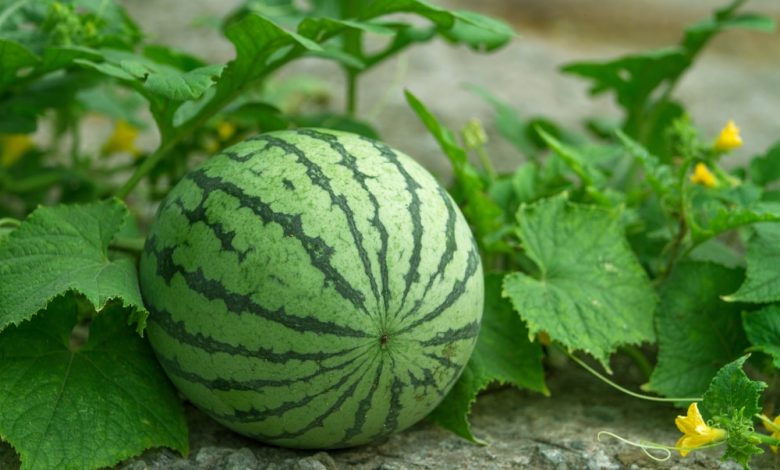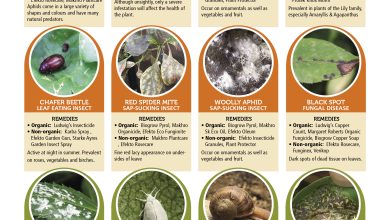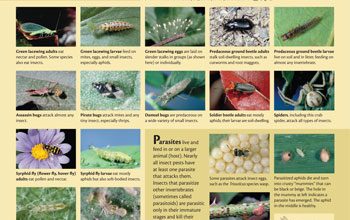How to Fertilize Watermelons: [Components and Needs]

 How delicious to consume a juicy and sweet watermelon in summer! To achieve this, it is important to know how to fertilize watermelon crops.
How delicious to consume a juicy and sweet watermelon in summer! To achieve this, it is important to know how to fertilize watermelon crops.
Because if the plant is not well nourished, its production will be deficient and the internal content of the fruit will be affected.
You may also be interested in: How to prune watermelons.
Why fertilize watermelons?
For a watermelon plant to grow strong and have the chance to fill its fruits with excellent quality content, it needs nutrients.
These nutrients, in some cases , can be obtained from the soil if it has been selected according to the requirements of the watermelon.
 But the reality is that as he develops these will become insufficient and he will need the support of growers.
But the reality is that as he develops these will become insufficient and he will need the support of growers.
It is for this reason that the theme of the subscriber becomes so important in this whole issue, since it is through him that these nutrients are offered.
Of course, it is not worth doing it all the time in a messy way and with anything, it is essential to follow the recommended process.
What does the watermelon plant need?
 Like many other fruit-bearing plants, its requirements are oriented towards nitrogen, phosphorous, potassium, sulfur and calcium.
Like many other fruit-bearing plants, its requirements are oriented towards nitrogen, phosphorous, potassium, sulfur and calcium.
There are other chemical elements that also play a leading role in this whole process of growth and development of watermelons.
Among them are: magnesium, iron, manganese, boron, zinc, copper, molybdenum and chlorine.
Each of these elements has a specific function for the development of the plant.
For example, phosphorus does a very important job around root development, but it also helps the plant grow in general.
For extensive watermelon crops
In the event that the planting of watermelon has commercial and extensive intentions, we are going to see how we should proceed to prepare the land.
For a production of 40,000-60,000 kg/ha of watermelons:
- 150-200 kg of nitrogen.
- 100-125 kg of phosphorus.
- 300-400 kg of potassium.
Before planting the watermelons
- Ammonium sulfate 21%: 250 kg/ha
- Lime superphosphate 17%: 600 kg/ha
- Potash sulfate 50%: 200 kg/ha
- Potash sulfate: 200 kg/ha
- Magesic sulfate: 10kg/ha
Before flowering
- Ammonium nitrosulphate: 300 kg/ha
- Potash sulfate: 250 kg/ha
- Magnesium sulfate: 10 kg/ha
What are the main components of watermelon manure?
 For the fertilizer to work as desired, it will need to contain phosphorus, nitrogen and potassium as the main components.
For the fertilizer to work as desired, it will need to contain phosphorus, nitrogen and potassium as the main components.
All this is achieved through green and dry organic matter, also with humidity and air.
To get each of these elements it is not necessary to buy anything, with leftovers that we have available at home is more than enough.
What deficiencies can watermelon have and how to detect them?
Most nutrient deficiencies can be noticed visually through the weakening of the plant.
When you have a nitrogen failure, the following symptoms may occur:
- Cracks on the outside of the fruits, which also acquire an insipid taste.
- Expulsion of the flowers before completing the flowering process.
 Another case is with the phosphorus deficit that can be noticed in the condition that occurs on the oldest leaves.
Another case is with the phosphorus deficit that can be noticed in the condition that occurs on the oldest leaves.
Potassium is also essential for watermelon and when it is lacking, underdeveloped fruits are noticed.
If the deficiency is sulfur, the youngest leaves will begin to look yellowish and pale.
Orchard Trick:
Do you know legumes? (Beans, peas, broad beans, lentils …)
Well, legumes are an excellent natural fertilizer because they release nitrogen into the soil when you grow them. Therefore, it is a good idea to plant legumes near watermelons
How to make a composting compound for watermelons step by step?
 A good way to ensure that the compost contains the components that we have seen before is by adding them individually.
A good way to ensure that the compost contains the components that we have seen before is by adding them individually.
To get high amounts of nitrogen, the manure of farm animals is ideal. Worm humus is also an excellent option.
However, in order to apply it to the ground, it must be dry and this process can be done at home or get it ready in stores.
In the case of phosphorus and potassium, which are the other two important macronutrients, they can be obtained through wood ash.
To get this product just follow these steps:
- Select some pieces of wood that have become available from a carpentry shop or that you have at home.
- Define a safe and closed place to burn the wood. It is important here not to add any fuel, just allow it to burn at its own rate.
- It is important that the chosen place is sectored so that the ashes remain in one place and are easy to collect.
- After the previous process is complete and the ashes are at a good temperature, you will have to dilute them in tap water.
- Now it will be your turn to spread the ash water around the stem of the watermelon in adequate proportions to avoid creating puddles.
 A very important fact when selecting these fertilizer methods is that the land has good drainage.
A very important fact when selecting these fertilizer methods is that the land has good drainage.
Otherwise, there is a risk that excess moisture will alter the health of the roots and cause rotting.
Watermelons are very noble plants to generate quality production, but the more we help you, the better the results to be obtained.
If you have melons in your garden, congratulations! Because everything that is applicable to watermelons in this topic will also be helpful for melons
Where to buy fertilizer for watermelons?
It is best to go to a nursery or a specialized store in your area. However, if you don’t have access to either, we might recommend these products on Amazon:
 CULIVERS Special Fertilizer for Bonsai of 5 kg. Fertilizer of 100% Organic and Natural Origin, Granulated Slow Release and controlled with NPK 8-1-5 + 74% MO and Ac. Humic
CULIVERS Special Fertilizer for Bonsai of 5 kg. Fertilizer of 100% Organic and Natural Origin, Granulated Slow Release and controlled with NPK 8-1-5 + 74% MO and Ac. Humic
- Fertilizer in the form of slow and controlled release microgranules.
- Controlled growth of new internodes
- Ecological organic fertilizer with a high concentration of NPK.
- Organic fertilizer from high-quality plant material, obtained through controlled fermentation, for a…
€19.84 View on Amazon Prices with VAT without transport
Last updated on 2022-07-26 / Affiliate Links / Affiliate API Images
 Expert Advice Citrus Organico Organomineral fertilizer specific for citrus, 5 kg
Expert Advice Citrus Organico Organomineral fertilizer specific for citrus, 5 kg
- Npk 6-5-5 contains a high percentage of natural organic substances such as corknut, hops and neem panel.
- The neem panel is a substance of vegetable origin that restores the fertility of the exploited territories and favors…
- Distributed regularly throughout the year, it guarantees complete nutrition and optimal plant development.
- Fertilization period: from March to November; Frequency: every 30-40 days; How to use: shoot, lightly bury and…
View on Amazon Prices with VAT without transport
Last updated on 2022-07-26 / Affiliate Links / Affiliate API Images
 Suinga 500 KG ORGANIC FERTILIZER FERTILIZER Humus OF WORMS, Bags of 25 Kg – 41 liters. Suitable for organic farming
Suinga 500 KG ORGANIC FERTILIZER FERTILIZER Humus OF WORMS, Bags of 25 Kg – 41 liters. Suitable for organic farming
- Organic fertilizer suitable for Organic Farming obtained from earthworm droppings.
- They help the growth and development of all kinds of plants, improving the soil and caring for the environment.
- The earthworm humus is a product of organic origin that results from the transformation of animal manure carried out…
- It serves as a substrate for seedbeds (we recommend mixing with coconut fiber)
View on Amazon Prices with VAT without transport
Last updated on 2022-07-26 / Affiliate Links / Affiliate API Images




![Photo of Hydrangeas Care: [Soil, Humidity, Pruning and Problems]](https://www.complete-gardening.com/wp-content/uploads/2022/08/hydrangeas-care-soil-humidity-pruning-and-problems-390x220.png)